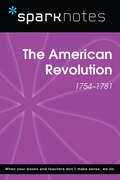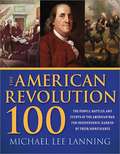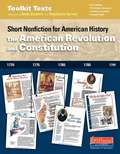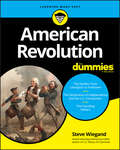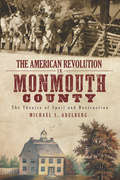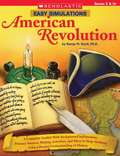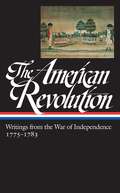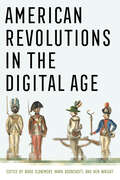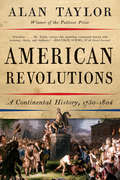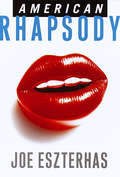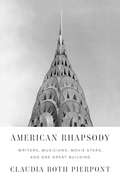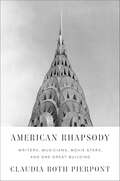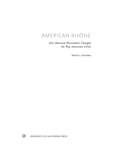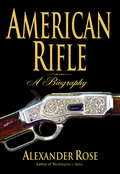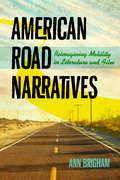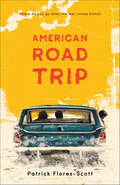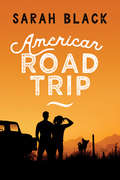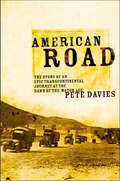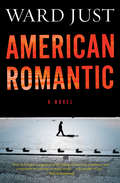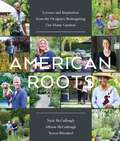- Table View
- List View
American Revolution (SparkNotes History Notes)
by SparkNotesAmerican Revolution (SparkNotes History Note) Making the reading experience fun! Created by Harvard students for students everywhere, SparkNotes is a new breed of study guide: smarter, better, faster. Geared to what today's students need to know, SparkNotes provides: chapter-by-chapter analysis explanations of key themes, motifs, and symbols a review quiz and essay topics Lively and accessible, these guides are perfect for late-night studying and writing papers.
American Revolution 100: The Battles, People, and Events of the American War for Independence, Ranked by Their Significance
by Michael Lee LanningA controversial ranking of the Revolution's biggest battles, events, and leaders. The American Revolution 100 brings you onto the charred battlefields and inside the maneuverings of the war that produced America. In comprehensive fashion it explains, analyzes, and ranks the war's most significant events, leaders, and battles according to their importance. Celebrated veteran and military expert Michael Lee Lanning introduces the war's various causes and primary players. The 100 ranked entries that follow include bloody battles, outspoken politicians, military heroes, causes of the conflict, and monumental events. The War of Independence pitted king against colonialist, monarchy against democracy. Men risked execution for treason in order to bring about the model government that would inspire a world. The American Revolution 100 brings to life its battles, people, and events, including maps and illustrations.
American Revolution And Constitution: Short Nonfiction For American History (Toolkit Texts)
by Stephanie Harvey Anne Goudvis52 short nonfiction texts for American History (1750-1800) with 10 new lessons for content literacy <P><P>"We turn information into knowledge by thinking about it. These texts support students in using the Toolkit's comprehension and thinking strategies as tools to acquire and actively use knowledge in history." -Stephanie Harvey and Anne Goudvis <P><P> To support cross-curricular strategy instruction and close reading for information, Stephanie Harvey and Anne Goudvis have expanded their Toolkit Texts series to include a library of short nonfiction for American history with 10 all-new Toolkit lessons. <P><P> Building on selections from popular children's magazines as well as original articles, these engaging, age-appropriate texts will keep your active literacy classroom awash in historical resources that depict the controversies, issues, and dramas that shaped historical events, including the exploits of lesser-known individuals. <P><P> These short nonfiction texts for American history include: <P> 10 comprehension strategy lessons for close reading in content literacy. Short nonfiction articles on a wide range of topics and at a variety of reading levels. ( 45 articles in Colonial Times and 52 articles in The American Revolution and Constitution ) A bank of historical images, primary source documents and artifacts, plus primary source documents and artifacts bibliographies, web sites, and ideas for online investigations. A Digital Companion Resource provides all of the texts, primary source documents, and the image bank in a full-color digital format so you can display them for group analysis. Lesson Title 1 Read and Annotate: Stop, think, and react using a variety of strategies to understand 2 Annotate Images: Expand understanding and learning from visuals 3 Build Background to Understand a Primary Source: Read and paraphrase secondary sources to create a context for a topic 4 Read and Analyze a Primary Source: Focus on what you know and ask questions to clarify and explain 5 Compare Perspectives: Explore the different life experiences of historical figures 6 Read Critically: Consider point of view and bias 7 Organize Historical Thinking: Create a question web 8 Read with a Question in Mind: Focus on central ideas 9 Surface Common Themes: Infer the big ideas across several texts 10 Synthesize Information to Argue a Point: Use claim, evidence, and reasoning The CCSS and other state standards expect that children will read a variety of texts on a common topic and synthesize the ideas and information. <P><P> These short nonfiction texts were selected using the following criteria: Interest/Content Because kids love the quirky and the unexpected, these texts highlight important but often lesser-known or unrecognized perspectives and voices from the past. Visual literacy Since visual literacy is an essential 21st-century skill, these texts include historical images, paintings, and maps, as well as diagrams, timelines, charts, and photographs. Writing quality and accuracy To foster student engagement, these articles feature vibrant language in an active voice supported by a rich assortment of visual features. Reading level/complexity These texts are written at a range of reading levels and include a wide variety of topics to capture the interests of all readers.
American Revolution For Dummies
by Steve WiegandBecome an expert on the Revolutionary War American Revolution For Dummies capitalizes on the recent resurgence of interest in the Revolutionary War period—one of the most important in the history of the United States. From the founding fathers to the Declaration of Independence, and everything that encapsulates this extraordinary period in American history, American Revolution For Dummies is your one-stop guide to the birth of the United States of America. Understanding the critical issues of this era is essential to the study of subsequent periods in American history … and this book makes it more accessible than ever before. Covers events leading up to the war, including the Sugar Act, Stamp Act, and the Boston Tea Party Provides information on The Declaration of Independence Offers insight on major battles, including the Battles of Lexington and Concord, Bunker Hill, and Yorktown Reviews key figures, including George Washington, Charles Cornwallis, the Marquis de Lafayette, and Alexander Hamilton If you want or need to become more knowledgeable about the American War of Independence and the people and period surrounding it, this book gives you the information necessary to become an expert on the essential details of the revolutionary period.
American Revolution in Monmouth County, The: The Theatre of Spoil and Destruction (Military)
by Michael S. AdelbergLike much of New Jersey during the American Revolution, Monmouth County was contested territory in between the great armies. As the Battles of Trenton, Princeton and Bound Brook raged nearby, the people of Monmouth County fought their own internal revolution; Loyalist partisans led insurrections and raids that laid waste to entire neighborhoods. In 1778, General George Washington rallied his Continental army and fought the British within Monmouth's borders, barely holding the field. Monmouth Countians joined the fight and then spent the following weeks caring for the wounded and burying the dead. The remaining war years brought more hardships, as they grappled with a local civil war charged with racial, religious and economic undercurrents--a local civil war that continued long after the Battle of Yorktown supposedly ended hostilities. Revolutionary War scholar Michael S. Adelberg brings to life the struggles within Monmouth County, a place that New Jersey governor William Livingston called "the theatre of spoil and destruction."
American Revolution, 1700-1800 (Chronicle of America Series)
by Joy MasoffThe second volume of the Chronicle of America series examines the American Revolution, describing life in the colonies during the years between 1700 and 1800, when the colonists were struggling to establish their independence from Great Britain.
American Revolution: A Complete Toolkit With Background Information, Primary Sources, And More That Help Students Build Reading And Writing Skills-and Deepen Their Understanding Of History
by Renay M. ScottWhat better way to learn about history than to relive it? Students assume the roles of colonists, patriots, and loyalists as they participate in a weeklong simulation that takes them through the events that led to and ended the American Revolution. Includes easy step-by-step directions, plus reproducible student worksheets, tables, maps, and rubrics-everything you need to run a successful simulation! For use with Grades 5 & Up.
American Revolution: A Nonfiction Companion to Revolutionary War on Wednesday
by Mary Pope OsborneWHY DID WE fight the Revolutionary War? What is the Declaration of Independence? What was it like to live in the 13 colonies? Find out the answers to these questions and more in Magic Tree House Research Guide: American Revolution, Jack and Annie's guide to one of the most important events in our nation's history. This is the nonfiction companion to Revolutionary War on Wednesday(Magic Tree House #22). "A great place to begin research for a report."--School Library Journal
American Revolution: Activity Book (Amplify Core Knowledge Language Arts, Grade 4 #Unit 7)
by Amplify EducationNIMAC-sourced textbook
American Revolution: Reader (Amplify Core Knowledge Language Arts, Grade 4 #Unit 7)
by Amplify EducationNIMAC-sourced textbook
American Revolution: Writings from the War of Independence
by Various John H. RhodehamelOne of the Library of America's editions of historic writings, this is a collection of papers from the Revolutionary period. It starts with Paul Revere's own account of his famous ride in 1775 and ends with a description of George Washington's resignation from the Continental Army in 1783. Journal entries, letters, newspaper articles, and public documents are included, written by Revolutionary leaders, soldiers and their wives, British officers, and Colonial loyalists. Annotation copyrighted by Book News Inc. , Portland, OR
American Revolutions in the Digital Age
by Ben Wright Mark Boonshoft Nora SlonimskyThe interdisciplinary essays in American Revolutions in the Digital Age explore what digital tools can tell us about the late eighteenth- and early nineteenth-century United States and reveal how an understanding of the American past can make sense of our digital present. By employing a host of innovative digital research methods, these authors challenge long-held assumptions about the American past. In addition, this collection uniquely demonstrates how contemporary anxieties about an array of topics, including media disinformation, patriarchy, economic inequality, and public memory, can be better understood through careful considerations of early American history.Open Access edition funded by Iona University
American Revolutions: A Continental History, 1750 - 1804
by Alan Taylor“Excellent . . . deserves high praise. Mr. Taylor conveys this sprawling continental history with economy, clarity, and vividness.”—Brendan Simms, Wall Street Journal The American Revolution is often portrayed as a high-minded, orderly event whose capstone, the Constitution, provided the nation its democratic framework. Alan Taylor, a two-time Pulitzer Prize winner, gives us a different creation story in this magisterial history. The American Revolution builds like a ground fire overspreading Britain’s colonies, fueled by local conditions and resistant to control. Emerging from the continental rivalries of European empires and their native allies, the revolution pivoted on western expansion as well as seaboard resistance to British taxes. When war erupted, Patriot crowds harassed Loyalists and nonpartisans into compliance with their cause. The war exploded in set battles like Saratoga and Yorktown and spread through continuing frontier violence. The discord smoldering within the fragile new nation called forth a movement to concentrate power through a Federal Constitution. Assuming the mantle of “We the People,” the advocates of national power ratified the new frame of government. But it was Jefferson’s expansive “empire of liberty” that carried the revolution forward, propelling white settlement and slavery west, preparing the ground for a new conflagration.
American Rhapsody
by Carol StoneThe author's romanticizing and grieving for her lost parents and America extends from the Prohibition era, its glamour and notoriety, with figures like Warren Harding and Josephine Baker to Enron, urban decay, and illegal immigration.
American Rhapsody
by Joe EszterhasIf the Watergate scandal was a previous generation's National Nightmare, then maybe the Clinton scandal was our National Wet Dream, and who better to narrate it than the screenwriter Joe Eszterhas? In American Rhapsody, Eszterhas, whose credits include Basic Instinct and Showgirls, and Charlie Simpson's Apocalypse, for which he was nominated for a National Book Award, takes us through the events that threatened to topple a president and left most of the nation's citizens with, at the very least, a bad taste in their mouths. Taking full advantage of his considerable journalistic and storytelling talents, Eszterhas gives us every fact, rumor, or innuendo surrounding the president's foibles in the context of late century American politics and entertainment. Here Washington and Hollywood do more than just flirt with each other; they share the same bed. From scandalmongers Matt Drudge (who began as a Hollywood gossip) and Ken Starr, to would-be president paramours Sharon Stone and Barbra Streisand, to his final, unimpeachable witness, Willard--none other than President Clinton's talking penis--Eszterhas gives us the goods on the story that nobody could stop talking about and, thanks to American Rhapsody, will be impossible to think about the same way again.From the Trade Paperback edition.
American Rhapsody: Writers, Musicians, Movie Stars, and One Great Building
by Claudia Roth PierpontRanging from the shattered gentility of Edith Wharton's heroines to racial confrontation in the songs of Nina Simone, American Rhapsody presents a kaleidoscopic story of the creation of a culture. Here is a series of deeply involving portraits of American artists and innovators who have helped to shape the country in the modern age. Claudia Roth Pierpont expertly mixes biography and criticism, history and reportage, to bring these portraits to life and to link them in surprising ways. It isn't far from Wharton's brave new women to F. Scott Fitzgerald's giddy flappers, and on to the big-screen command of Katharine Hepburn and the dangerous dames of Dashiell Hammett's hard-boiled world. The improvisatory jazziness of George Gershwin's Rhapsody in Blue has its counterpart in the great jazz baby of the New York skyline, the Chrysler Building. Questions of an American acting style are traced from Orson Welles to Marlon Brando, while the new American painting emerges in the gallery of Peggy Guggenheim. And we trace the arc of racial progress from Bert Williams's blackface performances to James Baldwin's warning of the fire next time, however slow and bitter and anguished this progress may be. American Rhapsody offers a history of twentieth-century American invention and genius. It is about the joy and profit of being a heterogeneous people, and the immense difficulty of this human experiment.
American Rhapsody: Writers, Musicians, Movie Stars, and One Great Building
by Claudia Roth PierpontRanging from the shattered gentility of Edith Wharton's heroines to racial confrontation in the songs of Nina Simone, American Rhapsody presents a kaleidoscopic story of the creation of a culture. Here is a series of deeply involving portraits of American artists and innovators who have helped to shape the country in the modern age.Claudia Roth Pierpont expertly mixes biography and criticism, history and reportage, to bring these portraits to life and to link them in surprising ways. It isn't far from Wharton's brave new women to F. Scott Fitzgerald's giddy flappers, and on to the big-screen command of Katharine Hepburn and the dangerous dames of Dashiell Hammett's hard-boiled world. The improvisatory jazziness of George Gershwin's Rhapsody in Blue has its counterpart in the great jazz baby of the New York skyline, the Chrysler Building. Questions of an American acting style are traced from Orson Welles to Marlon Brando, while the new American painting emerges in the gallery of Peggy Guggenheim. And we trace the arc of racial progress from Bert Williams's blackface performances to James Baldwin's warning of the fire next time, however slow and bitter and anguished this progress may be.American Rhapsody offers a history of twentieth-century American invention and genius. It is about the joy and profit of being a heterogeneous people, and the immense difficulty of this human experiment.
American Rhone: How Maverick Winemakers Changed the Way Americans Drink
by Patrick J. ComiskeyNo wine category has seen more dramatic growth in recent years than American Rhône-variety wines. Winemakers are devoting more energy, more acreage, and more bottlings to Rhône varieties than ever before. The flagship Rhône red, Syrah, is routinely touted as one of California's most promising varieties, capable of tremendous adaptability as a vine, wonderfully variable in style, and highly expressive of place. There has never been a better time for American Rhône wine producers. American Rhône is the untold history of the American Rhône wine movement. The popularity of these wines has been hard fought; this is a story of fringe players, unknown varieties, and longshot efforts finding their way to the mainstream. It's the story of winemakers gathering sufficient strength in numbers to forge a triumph of the obscure and the brash. But, more than this, it is the story of the maturation of the American palate and a new republic of wine lovers whose restless tastes and curiosity led them to Rhône wines just as those wines were reaching a critical mass in the marketplace. Patrick J. Comiskey's history of the American Rhône wine movement is both a compelling underdog success story and an essential reference for the wine professional.
American Rifle: A Biography
by Alexander RoseGeorge Washington insisted that his portrait be painted with one. Daniel Boone created a legend with one. Abraham Lincoln shot them on the White House lawn. And Teddy Roosevelt had his specially customized. Now, in this first-of-its-kind book, historian Alexander Rose delivers a colorful, engrossing biography of an American icon: the rifle. Drawing on the words of soldiers, inventors, and presidents, based on extensive new research, and encompassing the Revolution to the present day,American Rifleis a balanced, wonderfully entertaining history of this most essential firearm and its place in American culture. In the eighteenth century American soldiers discovered that they no longer had to fight in Europe's time-honored way. With the evolution of the famed "Kentucky" Rifle--a weapon slow to load but devastatingly accurate in the hands of a master--a new era of warfare dawned, heralding the birth of the American individualist in battle. In this spirited narrative, Alexander Rose reveals the hidden connections between the rifle's development and our nation's history. We witness the high-stakes international competition to produce the most potent gunpowder . . . how the mysterious arts of metallurgy, gunsmithing, and mass production played vital roles in the creation of American economic supremacy . . . and the ways in which bitter infighting between rival arms makers shaped diplomacy and influenced the most momentous decisions in American history. And we learn why advances in rifle technology and ammunition triggered revolutions in military tactics, how ballistics tests--frequently bizarre--were secretly conducted, and which firearms determined the course of entire wars. From physics to geopolitics, from frontiersmen to the birth of the National Rifle Association, from the battles of the Revolution to the war in Iraq,American Rifleis a must read for history buffs, gun collectors, soldiers--and anyone who seeks to understand the dynamic relationship between the rifle and this nation's history.
American Road Narratives: Reimagining Mobility in Literature and Film (Cultural Frames, Framing Culture)
by Ann BrighamThe freedom to go anywhere and become anyone has profoundly shaped our national psyche. Transforming our sense of place and identity--whether in terms of social and economic status, or race and ethnicity, or gender and sexuality--American mobility is perhaps nowhere more vividly captured than in the image of the open road. From pioneer trails to the latest car commercial, the road looms large as a form of expansiveness and opportunity.Too often it is the celebratory idea of the road as a free-floating zone moving the traveler beyond the typical concerns of space and time that dominates the discussion. Rather than thinking of mobility as an escape from cultural tensions, however, Ann Brigham proposes that we understand mobility as a mode of engagement with them. She explores the genre of road narratives to show how mobility both thrives on and attempts to manage shifting conflicts about space and society in the United States.From the earliest transcontinental automobile narratives from the 1910s, through classics like Jack Kerouac's On the Road and the film Thelma & Louise, up to post-9/11 narratives, Brigham traces the ways in which mobility has been imagined, created, and interrogated over the past century and shows how mobility promises, and threatens, to incorporate the outsider and to blur boundaries. Bringing together textual and cultural analysis, theories of spatiality, and sociohistorical frameworks, this book offers an invigoratingly different view of mobility and a new understanding of the road narrative's importance in American culture. Cultural Frames, Framing Culture
American Road Trip
by Patrick Flores-ScottA heartwrenching YA coming of age story about three siblings on a roadtrip in search of healing.With a strong family, the best friend a guy could ask for, and a budding romance with the girl of his dreams, life shows promise for Teodoro “T” Avila. But he takes some hard hits the summer before senior year when his nearly perfect brother, Manny, returns from a tour in Iraq with a devastating case of PTSD. In a desperate effort to save Manny from himself and pull their family back together, T’s fiery sister, Xochitl, hoodwinks her brothers into a cathartic road trip.Told through T’s honest voice, this is a candid exploration of mental illness, socioeconomic pressures, and the many inescapable highs and lows that come with growing up—including falling in love. Christy Ottaviano Books
American Road Trip
by Sarah BlackA single moment—or a single mistake—can change everything. When Captain James Lee Hooker and his lover, Sergeant Easy Jacobs, were in the Army, they made a mistake that got a young soldier hurt. Three years later, they’re civilians again, living far apart, haunted by what they lost. Now that young soldier needs their help. With his grandmother’s one-eyed Chihuahua riding shotgun, James Lee climbs into Easy’s pickup for a trip across the American Southwest. They set out to rescue a friend, but their journey transforms them with the power of forgiveness.
American Road: The Story of an Epic Transcontinental Journey at the Dawn of the Motor Age
by Pete DaviesA fascinating account of the greatest road trip in American history.On July 7, 1919, an extraordinary cavalcade of sixty-nine military motor vehicles set off from the White House on an epic journey. Their goal was California, and ahead of them lay 3,250 miles of dirt, mud, rock, and sand. Sixty-two days later they arrived in San Francisco, having averaged just five miles an hour. Known as the First Transcontinental Motor Train, this trip was an adventure, a circus, a public relations coup, and a war game all rolled into one. As road conditions worsened, it also became a daily battle of sweat and labor, of guts and determination. American Road is the story of this incredible journey. Pete Davies takes us from east to west, bringing to life the men on the trip, their trials with uncooperative equipment and weather, and the punishing landscape they encountered. Ironically one of the participants was a young soldier named Dwight Eisenhower, who, four decades later, as President, launched the building of the interstate highway system. Davies also provides a colorful history of transcontinental car travel in this country, including the first cross-country trips and the building of the Lincoln Highway. This richly detailed book offers a slice of Americana, a piece of history unknown to many, and a celebration of our love affair with the road.
American Romantic: A Novel
by Ward JustA young diplomat is torn between two women during the earliest days of the Vietnam War in this &“wide-ranging and well-written&” novel (The Christian Science Monitor). Harry Sanders is a young Foreign Service officer in 1960s Indochina when the course of his life is suddenly altered by a dangerous and clandestine meeting with insurgents that ends in quiet disaster—and a brief but passionate encounter with Sieglinde, a young German woman. Absorbing the impact of his misstep, Harry returns briefly to Washington before traveling to Africa, Scandinavia, and the Mediterranean on assignments. He marries the captivating May, who is fleeing her own family disappointments in New England and looking for an escape into Harry&’s diplomatic life. On the surface, they are a handsome, successful couple—but the memory of Sieglinde persists in Harry&’s thoughts, and May has her own secrets too. As Harry navigates the increasingly treacherous waters of diplomacy in an age of interminable conflict, he also tries to narrow the distance between himself and the two alluring women who have chosen to love him, in a novel from a Pulitzer Prize and National Book Award finalist that &“considers the toll that a life lived upon the great stage of international politics can take on a man of substance&” (Kirkus Reviews).
American Roots: Lessons and Inspiration from the Designers Reimagining Our Home Gardens
by Nick McCullough Allison McCullough Teresa Woodard&“I love this book. Here are home gardens of designers from every part of our great country that are inspiring proof of a passionate vitality and freshness in American gardening today.&” — Page Dickey, author of Uprooted In recent years, bold designers have begun championing an American design aesthetic that embraces regional cultures, plants, and growing conditions. In American Roots, Nick McCullough, Allison McCullough, and Teresa Woodard highlight designers and creatives with exceptional home gardens, focused on those who push the boundaries, trial extraordinary plants, embrace a regional ethos, and express their talents in highly personal ways. Covering all the regions of the country, the profiles dive into design influences, share the back stories of the gardens and their creators, and include design tips and plant suggestions. American Roots is a beautiful invitation to reconsider how we define the American garden, filled with guidance and encouragement for anyone looking to dig more deeply into their own home garden.
